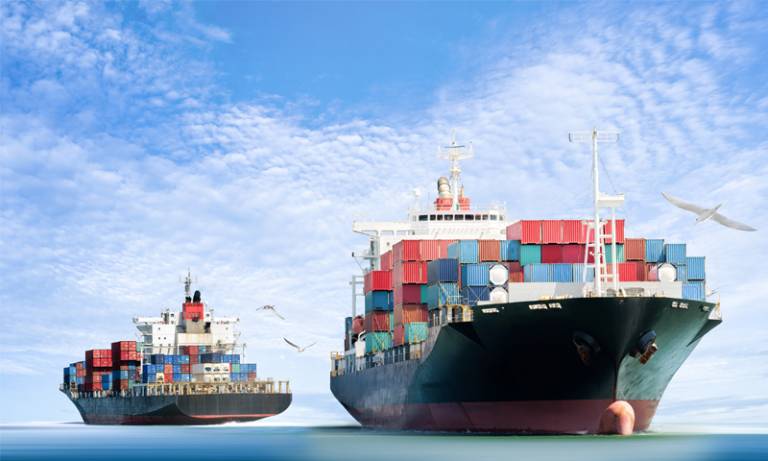Over 40% of U.S. shipping fleet energy could be replaced with zero emissions solutions this decade
12 April 2022
The United States has enormous potential to lead shipping’s decarbonization finds a new report from UCL Energy Institute’s shipping consultancy partnership UMAS.

A new report by UMAS, commissioned by The Ocean Conservancy titled “The Maritime Fleet of the USA—the current status and potential for the future” shows, for the first time, the scale of U.S. shipping fleet emissions and opportunities to decarbonise the sector. In 2018, carbon emissions from all U.S.-flagged vessels amounted to around 26 million tonnes, approximately 2.4% of global shipping emissions. Domestic shipping voyages accounted for about 70% of carbon emissions from the U.S.-flagged shipping fleet, which presents a unique opportunity for U.S. actions to effectively decarbonize the American maritime sector.
More than 40% of the energy used by the U.S. fleet could be replaced with zero emissions solutions this decade. The report estimates that 17% of the current U.S. fleet’s energy demands can be substituted with electrification. This would mean, for example, ships relying on battery electrification for shorter voyages or ships running off onshore electric power sources when in harbor. The Gulf of Mexico and northwest coasts of the U.S. are primed to move towards electrification given existing routes. A further 24% of the U.S. fleet’s energy demands, oftentimes coming from longer voyages than battery power alone can support, can be met with zero-emissions fuels such as green hydrogen. These technologies are already available and adopting them would require minimal infrastructure updates and can happen within the existing renewal schedule and will not require needing to scrap and rebuild ships ahead of schedule. The Pacific, Gulf of Mexico and Great Lakes are top candidates for the adoption of zero-emission fuels.
“There is enormous potential for the U.S. to be a global leader in maritime decarbonization. This is due to 3 main factors: energy and technology expertise, lots of coastal and inland shipping activity and geographically favorable conditions. Our models show that this combination makes the U.S a prime candidate for developing domestic and international green corridors. The current ambitious administration has the chance to make this a decade of change for the industry in the U.S. at the time when rapid action is needed to achieve science-based climate targets.”
– Dr Jean-Marc Bonello, Principal Consultant at UMAS.
In order to meet climate targets set by the U.S. government, the sector must transition away from the use of fossil fuels and shift towards true zero-emission fuels. “The U.S. is calling for the ambitious goal of 100% zero-carbon global shipping by 2050, and this report explores how we can lead the way through actions that decarbonize the U.S. domestic fleet” says Delaine McCullough, policy manager for Ocean Conservancy’s Shipping Emissions program. “Through policies and investments that drive innovation in vessel propulsion systems, zero-emission fuels and infrastructure, the U.S. can strengthen domestic industry, create good jobs and accelerate the global shipping transition.”
Existing US regulations under the Jones Act – which, among other things, requires goods transported between US ports be carried on vessels flying the U.S. flag that are also built in the U.S. and owned and operated by US citizens – provide the United States with a unique opportunity to drive decarbonization of domestic shipping and the adoption of zero-emission fuels and electrification. By already relying on US production, the domestic fleet can introduce new zero-carbon vessels as older vessels are decommissioned or retrofitted on already existing schedules. By acting early to decarbonize domestic shipping, the U.S. can create new jobs and help build domestic firms’ market share globally in both shipping and emerging zero-emissions fuels, particularly hydrogen-based fuels.
By transitioning the domestic fleet away from fossil fuels, the U.S. can become a global leader in shipping decarbonization and kickstart the international transition to zero emissions shipping. Eliminating carbon emissions from the shipping industry is essential if the U.S. and countries around the world are serious about meeting the goals of the Paris Agreement as well as their own domestic climate goals.
Links and further information
The full report and associated infographics can be downloaded from the following links:
- The Maritime Fleet of the USA—the current status and potential for the future
- Understanding the US-flagged fleet Infographic
- Mapping decarbonisation potential of clusters and routes Infographic
Ocean Conservancy is working to protect the ocean from today’s greatest global challenges. Together with our partners, we create science-based solutions for a healthy ocean and the wildlife and communities that depend on it. For more information, visit oceanconservancy.org, or follow us on Facebook, Twitter or Instagram.
UMAS delivers consultancy services and undertakes research for a wide range of clients in the public and private sectors using models of the shipping system, shipping big data, and qualitative and social science analysis of the policy and commercial structure of the shipping system. UMAS’s work is underpinned by state-of-the-art data supported by rigorous models and research practices, which makes UMAS world-leading on three key areas; using big data to understand drivers of shipping emissions, using models to explore shipping’s transition to a zero emissions future and providing interpretation to key decision makers. For more information visit: www.u-mas.co.uk
Media enquiries
For media enquiries please contact:
- Dr Nishatabbas Rehmatulla n.rehmatulla@ucl.ac.uk
- Dr Jean-Marc Bonello jean-marc.bonello@u-mas.co.uk
 Close
Close

